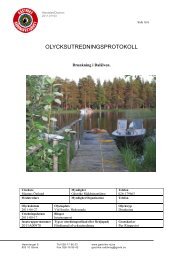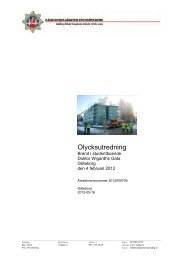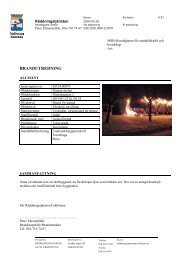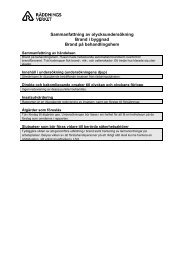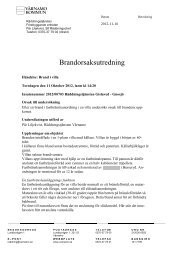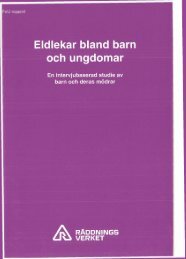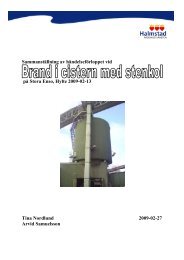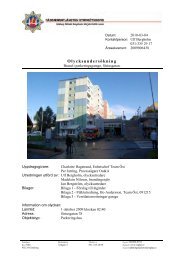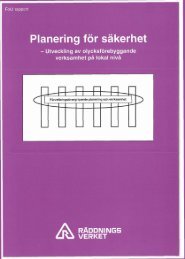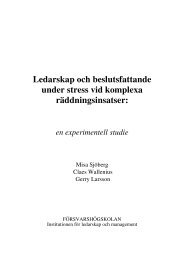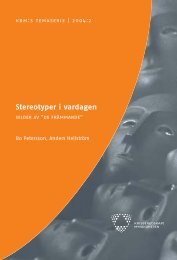Spontaneous Ignition - A Litterature Study of Experimental Methods
Spontaneous Ignition - A Litterature Study of Experimental Methods
Spontaneous Ignition - A Litterature Study of Experimental Methods
Create successful ePaper yourself
Turn your PDF publications into a flip-book with our unique Google optimized e-Paper software.
4AcknowledgementThe work presented in this report has been financed by the support <strong>of</strong> the Swedish EnergyAgency (STEM), the Swedish Rescue Services Agency (SRV) and the Swedish Board forFire Research (Brandforsk).
5NomenclatureA pre-exponential factor in Arrhenius expression (s -1 )B dimensionless adiabatic temperature rise (-)hLBi Biot number, ( Bi ) (-)c 0 ambient oxygen concentration by volume (-)C specific heat <strong>of</strong> the reaction products (J kg -1 K -1 )C p specific heat <strong>of</strong> the bulk material (J kg -1 K -1 )D diffusion coefficient (m 2 s -1 )E activation energy (J mol -1 )h heat transfer coefficient (W m -2 K -1 )L characteristic length (m)n order <strong>of</strong> reaction (-)P constant, equation (11) (-)q heat generation term, equation (1) (W m -3 )Q heat <strong>of</strong> reaction (J kg -1 )Q 0 heat <strong>of</strong> reaction by volume <strong>of</strong> oxygen (J m -3 )R universal gas constant (J mol -1 K -1 )t time (s)T temperature (K)T 0 ambient temperature (K)x length co-ordinate (m)Greek symbols Frank-Kamenetskii parameter, equation (3) (-) c critical value <strong>of</strong> (-)RT small parameter, ( 0) (-)E oxygen diffusion parameter, equation (9) (-) thermal conductivity (W m -1 K -1 ) bulk density (kg m -3 )
71 Introduction<strong>Spontaneous</strong> combustion <strong>of</strong> long-term storage is a long-standing practical problem that,in spite <strong>of</strong> extensive and intensive studies, has proved to be so intractable that there is stillneed for a definitive-working model capable <strong>of</strong> prediction <strong>of</strong> ignition behaviour withaccuracy. An accurate prediction <strong>of</strong> fire risk requires an adequate description <strong>of</strong> theinitiation and development <strong>of</strong> a fire. The problem is compounded by the uncertainphysical and chemical behaviour involved at ambient conditions and presents difficulties<strong>of</strong> practical control to restrict the temperature increase in storage.The dominant source <strong>of</strong> heat is the hydrocarbon oxidation governed essentially by therates <strong>of</strong> diffusion and convection <strong>of</strong> air from outside, however there can also besignificant influence <strong>of</strong> heat <strong>of</strong> wetting from adsorption <strong>of</strong> the inherent moisture.Various exothermic processes such as low temperature oxidation, microbial metabolism,the adsorption-desorption <strong>of</strong> water due to the difference between real and equilibriummoisture concentration in a storage and air and oxidation <strong>of</strong> volatile and reactivecompounds can contribute to self-heating <strong>of</strong> materials in storage and spontaneouscombustion.As Sweden aligns itself with the EU Waste Directive, there will be some major changesin the disposal <strong>of</strong> waste in the next few years. After 1 st January, 2002, it is prohibited bylaw to place combustible waste in a landfill. Similarly in 2005 it will be prohibited toplace organic waste in a landfill. In preparation for these changes Sweden has beenworking with collection and sorting <strong>of</strong> a variety <strong>of</strong> waste for the past 5-10 years. Thewaste is first divided into a number <strong>of</strong> fractions, which can then be disposed <strong>of</strong> indifferent ways. In many cases this waste will be stored for varying periods <strong>of</strong> time inanticipation either <strong>of</strong> material or energy recycling. These storage sites present enormouspotential environmental and safety problems.With the anticipated increase in storage volumes <strong>of</strong> combustible waste, a researchprogramme has been initiated by CECOST (Centre for Combustion Science andTechnology) with founding from the Swedish Energy Agency (STEM), the SwedishRescue Services Agency (SRV) and the Swedish Board for Fire Research (Brandforsk).The major participants in the project are: the Department <strong>of</strong> Fire Safety Engineering atLund University, the department <strong>of</strong> Fire Technology at SP Swedish National Testing andResearch Institute and Växjö University. The aim <strong>of</strong> the project is to conduct research onspontaneous ignition processes in storages <strong>of</strong> combustible materials and to developcomputational tools for accurate simulation <strong>of</strong> such processes.A literature review has been made on present theories and methods for prediction <strong>of</strong>spontaneous ignition. The results from this review are presented in this report. The reviewhas mainly concentrated on engineering models and the small-scale methods required toproduce input data for such models. Shortcomings <strong>of</strong> the models and specific problemsassociated with the applications to bi<strong>of</strong>uels have been addressed. Further, a survey <strong>of</strong> thepotential risk for spontaneous ignition in various bi<strong>of</strong>uel storages in Sweden has beenmade.
92 Evaluation <strong>of</strong> small-scale methods2.1 Frank-Kamenetskii theoryIn theoretical work on self-ignition problems one has <strong>of</strong>ten worked with the infinite slabgeometry, because <strong>of</strong> the relatively simple equation for energy conservation compared tomore complex geometries. The results for the slab can however normally be generalizedto other geometries by various techniques [1].Consider the energy equation for a slab:2T T C pq(1)2txwhere the left hand side is the rate <strong>of</strong> enthalpy change, the first term on the right handside represents the conductive heat transfer and q is the heat generation term. Thesolution <strong>of</strong> equation (1) would give the temperature distribution as a function <strong>of</strong> thedistance and time. Solving the equation for a material liable to spontaneous combustionwithin the temperature limits <strong>of</strong> ignition would yield a slow steady increase intemperature with an abrupt transition to a large and rapid raise at the moment <strong>of</strong> ignition.There are computational methods available to solve equation (1), but the methodintroduced by Frank- Kamenetskii for finding a stationary solution <strong>of</strong> the energy equationis <strong>of</strong>ten used as an engineering tool to make assessments <strong>of</strong> the risk for self-ignition.The stationary theory is based on the time-independent heat conduction equation withdistributed sources <strong>of</strong> heat. Under the steady (time-independent) assumption, equation (1)becomes:2 T q(2)2xThe solution <strong>of</strong> equation (2) gives the stationary temperature distribution in the slab. Theinitial conditions under which such a stationary distribution becomes impossible (i.e.where there is no solution for the equation) are interpreted as the critical conditions forignition.Most existing methods for prediction <strong>of</strong> spontaneous ignition are related to the Frank-Kamenetskii theory (F-K for short) and therefore this method is reviewed in more detailhere. A brief summary <strong>of</strong> the basic assumptions is given and limitations and appropriatecorrections are discussed.2.1.1 Basic assumptionsA requirement for self-ignition to occur is that the material is sufficiently porous andreactive so that adequate fuel and oxygen are available throughout the whole self-heatingprocess. The following assumptions constitute the basis <strong>of</strong> the stationary Frank-Kamenetskii theory, [2]:
101. Heat is generated by a single reaction whose rate at a given temperature is not afunction <strong>of</strong> time. The rate <strong>of</strong> internal heating is assumed to be a function <strong>of</strong>temperature according to the Arrhenius equation, i.e.,E/ RT (3)q QA ewhere Q is the heat <strong>of</strong> reaction, is the bulk density <strong>of</strong> the material, A is thereaction frequency, R is the universal gas constant, and E is the activation energy.RT2. The activation energy is assumed to be sufficiently high such that 0
12Oxygen diffusionThe effects <strong>of</strong> limited oxygen diffusion on the critical conditions for spontaneous ignitionhave been investigated by e.g. Takeno and Sato [8]. The effects <strong>of</strong> oxygen diffusion werefound to be governed by a parameter, , defined bynkT0 (10)c Q D00Here c 0 is the ambient concentration <strong>of</strong> oxygen by volume, Q 0 is the heat <strong>of</strong> reaction byvolume <strong>of</strong> oxygen, and D is the mass diffusion coefficient.Classical F-K theory assumes that
13The most common approach is instead to obtain groups <strong>of</strong> parameters (in equation (4)) bysearching for critical behaviour in a material under controlled ambient conditions. Thenormal procedure is to conduct small-scale tests using a pre-heated air oven with thesample placed in a wire-mesh container in the centre <strong>of</strong> the oven. In order to comply withthe condition <strong>of</strong> a high Bi-number in the F-K theory the air in the oven is re-circulated tocreate high convection from the sample surface. Critical conditions within the sample aredetermined from temperature measurements using fine thermocouples.2.2.1 The ‘Frank-Kamenetskii method’This indirect evaluation <strong>of</strong> the Frank-Kamenetskii parameter is based on thedetermination <strong>of</strong> the critical temperature for a known size <strong>of</strong> a material in small-scaleoven tests. If rewriting equation (4) as shown below Tln L202 P ERT0(11)where, E Q AP ln R (12)2 2it can be seen that a plot <strong>of</strong> ln( cT 0/ L ) versus 1/T0for a number <strong>of</strong> tests with varyingsample sizes (L) would form a straight line with - E/R as the slope and P as intercept. Thecritical F-K parameters ( ) for the geometries tested have to be calculated according tocthe principles discussed in Section 2.1.2. Thus E and QA could be extracted from suchmeasurements.Once these material parameters are determined from the small-scale tests it would bepossible to predict the critical size for any full-scale configuration (see equation (5)), or tocalculate the Frank-Kamenetskii parameter for any specific configuration and comparewith the critical parameter to get an assessment <strong>of</strong> the criticality <strong>of</strong> such a configuration.In practice the „F-K method” involves a number <strong>of</strong> separate, rather time consuming,heating tests with at least two different sizes <strong>of</strong> sample containers. Thin thermocouplesare used for measuring the temperature in the oven (T 0 ) and the temperatures at the centreand the periphery <strong>of</strong> the sample. The critical temperature (T 0 ) for each size <strong>of</strong> samplecontainer is determined by repetitive tests at oven temperatures successively closer to thecritical temperature. In this way the critical value <strong>of</strong> the temperature may be bracketed inas closely as desired. It is usually found that ignition is very sharply defined and adifference in oven temperature <strong>of</strong> only 0.5C will produce a sharp rise in the recordedcentral temperature [2]. The closeness with which the critical temperature is determined isobviously reflected in the precision <strong>of</strong> the calculation <strong>of</strong> the lumped kinetic parameters. Amaximum error <strong>of</strong> ±0.5C is recommended if data should be used for extrapolations overa wide range <strong>of</strong> sizes.
142.2.1.1 Examples <strong>of</strong> applicationsThere are several examples where the „F-K method‟ has been applied successfully for thestorage safety <strong>of</strong> coal [13] and other materials liable to spontaneous combustion, e.g.animal feedstuff and milk powder [2].Further some applications with biological materials normally used as fuels have beenreported in the literature. One <strong>of</strong> the most detailed studies <strong>of</strong> the self-ignition propensity<strong>of</strong> a bi<strong>of</strong>uel using the F-K methodology is that <strong>of</strong> Gray et al. [14]. They conducted smallscaleexperiments with bagasse using a pre-heated re-circulating air oven. Bagasse is theresidue from sugar cane processing, which is used as a fuel in boilers. Bagasse is acellulosic material, with the main components: cellulose (ca 40%), hemi-cellulose (ca30%) and lignin (ca 20%). The bagasse leaves the production plant with high watercontent (ca 50% by wt) and at a temperature <strong>of</strong> 50-70C. In these tests sieved (3 mmmesh) bagasse pit was used to get a homogeneous material.The tests were conducted with the samples in stainless steel, wire-mesh baskets <strong>of</strong>different sizes and shapes. The sample shapes tested and discussed in the paper werecubes, and cylinders. The cubes were <strong>of</strong> the sizes 50 mm and 100 mm. The types <strong>of</strong>cylinders were equicylinders, “squat” cylinders and “long” cylinders. Diameters <strong>of</strong> thecylinders varied between 20 mm for the long cylinder and 150 mm for the equicylinder.The critical Frank-Kamenetskii parameter was calculated for these different geometries.There was no correction applied for reactant consumption, other corrections applied in thecalculations can be found in the paper [14].A series <strong>of</strong> experiments was conducted at different oven temperatures for the variousgeometries to establish the critical temperature in each case. Different degrees <strong>of</strong> packingand water content were further investigated.The temperature development found in the tests might be divided into two periods. Firstthere was a fore period during which the sample was brought uniformly to the oventemperature (T 0 ). During this period the sample exhibited a quasi-stationary centraltemperature (61-75C) that was associated with the evaporation <strong>of</strong> water. The packingdensity affected the temperature attained during this period, and the duration <strong>of</strong> the periodwas controlled by the amount <strong>of</strong> water present. The second period was presumed to bethat <strong>of</strong> self-heating due to exothermic oxidation.The results from the tests can be summarized as follows:- Once T 0 was achieved uniformely throughout the sample, the same rate andextent <strong>of</strong> self-heating followed regardless <strong>of</strong> the amount <strong>of</strong> water initially present.- The critical temperature in each case was established reproducible with very highprecision (±0.25 K).- The distinction between subcritical and supercritical conditions was absolutelyclear.- The critical temperature was sensitive to both the size <strong>of</strong> the sample and itspacking density.- A higher packing density resulted in a lower critical temperature.- A rise <strong>of</strong> approximately 4.5 K was found for the surface temperature <strong>of</strong> thesample at the critical temperature. This finding was interpreted as an indicationthat it might be necessary to investigate the criteria for criticality particulate or fibrous systems (the Frank-Kamenetskii assumption iscin someBi ).
15The collected data from the tests were plotted for an indirect evaluation <strong>of</strong> the kineticparameters using the Frank-Kamenetskii relationship as described in Section 2.2.1. Theplot included data for all geometries investigated, both with natural packing density andgreater densities. Included in the plot were also additional results from tests withwoodflour (Beever, P., unpublished results).The results from the assessment <strong>of</strong> the experimental results showed that:- A least-mean-square line through the data points showed a good fit (including thedata on woodflour), and the gradient (15 ± 0.710 3 ) yielded effective activationenergy <strong>of</strong> 125 ± 6 kJ/mol.- Using the determined activation energy in a calculation <strong>of</strong> the critical temperatureexcess in the experiments conducted showed a good consistency between theexperimental measurements and the theoretical interpretations founded onconductive heat transfer.- Correction for reactant consumption did not seem to be necessary.There are other examples where researchers have applied the „F-K method‟ to woodmaterials. One such example is the work <strong>of</strong> Jones et al. [15] were seventeen differentsamples <strong>of</strong> leaves, wood shavings and forest floor litter were tested. In these tests cubicsteel gauze baskets were used ranging in size from 4 cm side to 10 cm, resulting in values<strong>of</strong> the critical temperature in the range 172 – 217C. Conclusion <strong>of</strong> this work was:- Supercritical temperature-time behaviour was clearly distinguishable fromsubcritical.- The samples <strong>of</strong> both forest litter and live vegetation showed good conformity tothe principles <strong>of</strong> the theory.- Consistency was shown by each sample gathered from a small area, butconsiderable variation was shown by samples gathered from different areas.- The measured activation energies for the various samples were in the range 82 –140 kJ mol -1 , however, it was seen that the pre-exponential factor varied much.2.2.2 The ‘crossing-point method’An alternative method for determination <strong>of</strong> the (lumped) kinetic parameters in selfheatingsubstances is the method described by Chen and Chong [16], commonly referredto as the „crossing-point temperature method‟. This method involves the peripheryheating <strong>of</strong> an initially „cold‟ exothermic material being subjected to a hot environmentwith a constant temperature, and is based on analysis <strong>of</strong> the non-steady solution <strong>of</strong> theenergy conservation equation.Consider a symmetrical material where the heat wave propagates towards the centre.Initially the centre temperature is lower than the periphery temperature (which ratherquickly exceeds the ambient temperature) and a temperature in the material a smalldistance from the centre (a few millimetres). At a certain time the centre temperatureexceeds the temperature measured a small distance from the centre. At that point wherethe centre temperature just exceeds the other temperature in the material, the centretemperature is defined as the „crossing-point temperature‟.It has been shown [16] that the observation <strong>of</strong> this unique temperature can be used as aphysic-chemical property to indicate the propensity <strong>of</strong> a solid material to self-heat.Consider the energy conservation equation for a one-dimensional slab
162T T C pQ AexpE / RT (13)2txwhere the left-hand side is the rate <strong>of</strong> enthalpy change within the solid, the first term onthe right-hand side is the conductive heat transfer, and the second term is the heatgeneration term <strong>of</strong> the lumped exothermic reactions (cf. the discussion in Section 2.1).The conductive heat transfer term in equation (13) would initially have a value <strong>of</strong> zero inthe centre <strong>of</strong> the periphery-heated slab. The second derivative <strong>of</strong> temperature againstdistance would take a positive increasing value initially as the slab is heated, but wouldeventually decrease and become negative as the centre temperature advances towards theperiphery temperature and passes it. It is thus evident that the conductive heat transferterm is zero at some point, and this is the more strict definition <strong>of</strong> the „crossing-pointtemperature‟. Thus at the crossing-point temperature (T p )2 T02x(14)and equation (13) at the centre <strong>of</strong> the slab is reduced toTQA expE / RTtCp(15)which could be rewritten to T QA Eln ln (16)t Cp RTThus if T p is identified experimentally, and a temperature-time pr<strong>of</strong>ile is recorded todetermine the time derivate <strong>of</strong> the temperature at T p , the kinetic parameters could bederived from a plot <strong>of</strong> ln T / tat T p against 1 /Tp.The main advantage <strong>of</strong> the crossing-point method is, that instead <strong>of</strong> carrying out series <strong>of</strong>time-consuming experiment with several sample sizes to obtain the data for the steadystateF-K plot, each <strong>of</strong> the transient experiments with the „crossing-point method‟ whereonly one sample size is needed, in a rather short time produces a point on the plot <strong>of</strong>ln T / tversus 1 /Tp. In order to obtain several data points for the plot the initialtemperature <strong>of</strong> the oven is varied.Cuzzillo has evaluated the „crossing-point method‟ in detail in his thesis [17]. A detailederror analysis <strong>of</strong> the method could be found here. Cuzzillo shows several advantages <strong>of</strong>the „crossing-point method‟ over the standard „F-K method‟. First, the already discussedadvantage, that almost every test results in a data point on the graph. Further, it eliminatesthe need to measure or estimate Bi in the laboratory tests because c need not to beevaluated in these tests. This means that the heat transfer properties <strong>of</strong> the oven and theconductivity <strong>of</strong> the sample need not to be known in the laboratory tests for determiningthe kinetic parameters.
17The kinetic data extracted from the laboratory tests can then be used according to whatwas discussed for the F-K theory in Section 2.1.1. Once the kinetic parameters areevaluated by the „crossing-point method‟, the Frank-Kamenetskii parameter, , can becalculated for any geometry according to equation (4), and be compared to the conditionfor criticality ( c ) <strong>of</strong> the object.The practical experimental procedure applied for the „crossing-point method‟ isillustrated in the examples in the next section.2.2.2.1 Examples <strong>of</strong> applicationsOne recent application <strong>of</strong> the „crossing-point method‟ is a study <strong>of</strong> low-temperatureoxidation <strong>of</strong> coals conducted by Nugroho et al. [18]. In this study the results from the„crossing-point method‟ was compared with that <strong>of</strong> the traditional F-K approach and agood agreement between the methods was found. It was concluded that the crossing-pointmethod was more convenient to use than the F-K approach, and yet sufficiently reliablefor the determination <strong>of</strong> the activation energy and the heat release times reactivity (QA).Chong et al. [19] applied the „crossing-point method‟ to determine the thermal ignitionkinetics <strong>of</strong> sawdust. Two types <strong>of</strong> sawdust were investigated, one treated with copperchromate-arsenic,and one untreated. The sawdust was sieved to remove any particleslarger than 5 mm. The moisture contents in the treated and the untreated wood was 6%and 2% respectively.The cubical sample containers used in the tests were made <strong>of</strong> No. 30 stainless steel mesh,and three sizes <strong>of</strong> the containers were used (5, 6 and 7 cm). The majority <strong>of</strong> the tests wereconducted using the 5 cm container. It should be noted that it is not necessary to usedifferent sizes <strong>of</strong> sample containers for the crossing-point method. The authors do notdiscuss the reason for using several sizes in this case, however, the results does notindicate any influence <strong>of</strong> the container size. K-type thermocouples were inserted into thesample to measure the temperature at three locations. The first measurement point was inthe centre <strong>of</strong> the sample, the second at 4 mm from the centre, and the third another 4 mmaway. All thermocouples were aligned in a straight line.The oven temperature in the tests ranged from 170 to 213C for the treated sawdust, andfrom 180 to 215C for the untreated sawdust. Crossing-point temperatures for the 5 cmbasket in the range between 183C and 226C were found for the treated sawdust, and inthe range between 181C and 227C for the untreated sawdust. The temperature in theoven was controlled to within ±2C <strong>of</strong> the temperature set-point. Each sample was heateduntil the temperature measured at the centre become higher than the temperaturesmeasured at the other two locations. A temperature-time plot was constructed for eachtest. From this plot the crossing-point temperature and the corresponding rate <strong>of</strong> changein temperature were determined.The authors report twelve tests for the treated sawdust with 5-cm cubes, one test for the6-cm cubes, and five tests with 7-cm cubes. The graph for this data yielded an activationenergy <strong>of</strong> 106±4 kJ mol -1 , and using a C p <strong>of</strong> 1700 J kg -1 K -1 gave a QA value <strong>of</strong> 2.4710 13J kg -1 s -1 . The activation energy for the untreated sawdust was 90±3 kJ mol -1 with a QAvalue <strong>of</strong> 3.1910 11 J kg -1 s -1 . The data for the untreated sawdust was based on nine testswith 5-cm cubes and four tests with 6-cm cubes. The authors further draw the conclusionthat the results indicate that there was only one dominant exothermic reaction present inthe temperature range. They do not, however, discuss how this conclusion can be made.
18These values can be compared with e.g. the activation energy <strong>of</strong> 102 kJ mol -1 calculatedby Bowes [1] for s<strong>of</strong>twood fibres. Bowes further states that for oxidative self-heating <strong>of</strong>carbonaceous materials, a value for E <strong>of</strong> 100 kJ mol -1 is usually a reliable estimate. TheQA values for the sawdust were however significantly higher compared to the result fors<strong>of</strong>twood boards (with an E <strong>of</strong> 101 kJ mol -1 recalculated using Bowes data [1]) that wasabout 1.5410 7 J kg -1 s -1 .2.2.3 Other oven heating methodsA method <strong>of</strong>ten referred to as the „heat release technique‟ has been developed by Jones[20] and shows many similarities to the crossing-point method. This method is howevernot so widely used. The two methods differ only in the way the centre temperature isdefined when the heat conduction term is neglected. This will result in a slight differenceconcerning the determination <strong>of</strong> the slope <strong>of</strong> the temperature-time curve and thecorresponding centre temperature.In the „heat release technique‟ the heat conduction term is neglected when the centretemperature <strong>of</strong> the sample exceeds the oven temperature while in the crossing pointmethod the heat conduction term is neglected when the temperature difference betweentwo neighbouring points at the centre <strong>of</strong> the sample becomes zero. At elevatedtemperatures the difference between these two centre temperatures can be substantial.This has led to a dispute between the inventors <strong>of</strong> the two methods but it seems that thematter has been at least partially settled as described in a note by Chen [Letter to theEditor, Fuel Vol. 79, 2000, pp 855-857].Björkman and Keski-Rahkonen have developed a transient method in a project sponsoredby Nordtest [21]. The method shares many features <strong>of</strong> the normal F-K methods, howeverthe temperature in the oven is continuously increased until self-ignition occurs. Twothermocouples are placed in the sample, and a special computer program control theheating and calculates the self-ignition temperature in the test. This method wasdeveloped to reduce the number <strong>of</strong> tests compared to the normal F-K approach but stillrequires several sizes <strong>of</strong> test containers. At the best case only three measurements areneeded for determining the material parameters <strong>of</strong> a material. A number <strong>of</strong> tests with oatmeat and bleaching powder samples are reported. However, the results are not comparedto those <strong>of</strong> other methods, and there is no discussion <strong>of</strong> possible errors.The concept <strong>of</strong> the „Frank-Kamenetskii method‟ is further used as a simplified generalmethod to assess the safety in shipping <strong>of</strong> bulk materials. The method is described in theUN “Recommendations on the Transport <strong>of</strong> Dangerous Goods, Manual <strong>of</strong> Tests andCriteria – Part III” [22]. In this test method („UN transport method‟ for short), tests areperformed to determine if a substance in a 25 mm or 100 mm sample cube, at testtemperatures <strong>of</strong> 100C, 120C or 140C, undergo spontaneous ignition or dangerous selfheating,which is indicated by a 60C rise in temperature over the oven temperaturewithin 24 hours. These criteria are based on the self-ignition temperature <strong>of</strong> charcoal,which is said in the standard to be 50C for a sample cube <strong>of</strong> 37 m 3 . The method ishowever used as a general method for all types <strong>of</strong> materials, and not only for charcoal.Some implications <strong>of</strong> application <strong>of</strong> the method to cellulosic materials are discussed inthe next section.
192.3 Predictions on large-scale systemsAll <strong>of</strong> the methods discussed in the preceding sections are design to give input data formore or less accurate assessments <strong>of</strong> storage safety <strong>of</strong> materials liable to spontaneousignition. Below some examples are given on such analyses specific for cellulosicmaterialsThe use <strong>of</strong> the „UN transport method‟ for various materials apart from charcoal has beencriticized. Bowes [1] point out that the use <strong>of</strong> a single point test implies an activationenergycommon for all materials to which the test might be applied, and that this in fact is77 kJ mol -1 . Jones et al. [23] has shown that the activation energy for peat is 134 kJ mol -1and that the use <strong>of</strong> the test method on peat would give a hugely erroneous answer,however on the safe side. Thus, the conclusion would be, that there is a need for a moreappropriate general small-scale method for assessment <strong>of</strong> transport safety for peat andother cellulosic materials.Gray et al. [14] analysed the applicability <strong>of</strong> the results from the „F-K method‟ forpredictions <strong>of</strong> real sized stockpiles <strong>of</strong> bagasse (residue from sugar-cane extraction). Theyidentified some major questions to be answered that would be <strong>of</strong> importance for anyapplication with real stockpiles <strong>of</strong> bi<strong>of</strong>uels.i) Can useful quantitative prediction be made from the small-scale F-K baseddata?ii) Is the simple kinetic interpretation appropriate and may fuel consumption beignored?iii) Are variations in thermal diffusivity to be expected?iv) What part is played by water in the stored material?In order to answer the first question (i) the authors calculated the maximum non-criticalmass for a stockpile <strong>of</strong> bagasse at normal ambient temperatures. The stockpiles in thiscalculation had the form <strong>of</strong> a rectangular rod with a base width <strong>of</strong> 18 m and a height <strong>of</strong> 4m. The prediction <strong>of</strong> critical conditions at an ambient temperature <strong>of</strong> 40 C gave a depth(or length) for the pile <strong>of</strong> 66 m. The same calculation for an ambient temperature <strong>of</strong> 20 Cgave a depth <strong>of</strong> 276 m. Experience from actual incidents, however, show according to theauthors, that these calculations vastly over-predicts the safe storage dimensions. Further,inclusion <strong>of</strong> reactant consumption in the calculations would further increase the predicteddimensions. The authors thus identifies that spontaneous ignition occurs in these types <strong>of</strong>stockpiles by mechanisms not described in the theoretical model applied (the F-Kmethod).On the question <strong>of</strong> the simple kinetic interpretation in the present model (ii) the authorsconclude that a more complex approach has to be used. They believe that the description<strong>of</strong> the temperature coefficient for the heat-release rate by a single Arrhenius term in awide range <strong>of</strong> temperatures is an over-simplification. They further say: “A pre-requisitefor assessing critical criteria in large stock-piles is thus to determine heat-release rates bycalorimetric methods at temperatures much closer to those usually encountered in normalclimatic conditions.”The question about thermal diffusivity (iii) has a strong coupling to the presence <strong>of</strong> waterin the material (iv).The laboratory tests were all carried out at a temperature above 100 C and thus theinfluence <strong>of</strong> water in the sample was not included these tests. Normal piles <strong>of</strong> bi<strong>of</strong>uel are
20however not dry but have moisture content that varies within the pile. The authorssummarize possible effects <strong>of</strong> the water content <strong>of</strong> the material:- Evaporation and loss <strong>of</strong> water is endothermic and would tend to stabilize thesystem.- Completely dry cellulosic materials are hygroscopic. The condensation <strong>of</strong> watervapour and evolution <strong>of</strong> its latent heat can be sufficient to cause self-heating.- Movement <strong>of</strong> water by evaporation and condensation do not give any net effecton the system but may locally cause hot spots to appear.- Balanced internal movement <strong>of</strong> water do not lead to identical conditions forcriticality <strong>of</strong> wet and dry masses. The thermal diffusivity within wet material isgreater than that within dry material. Thus the stability <strong>of</strong> the wet mass isenhanced.- Net loss <strong>of</strong> water from the system results in a gradual decrease in thermaldiffusivity (and thus stability).- As long as water remains in the system, liquid-phase oxidation and acidhydrolysis <strong>of</strong> hemicellulose may take place, making additional contributions tothe heat-release rate.Mehaffey et al. [24] have investigated the spontaneous ignition <strong>of</strong> insulating fibreboardpanels. The background was that several serious fires have occurred in Canada wheninsulating fibreboard panels were being transported. Critical temperatures for thespontaneous ignition <strong>of</strong> 75, 190 and 305 mm cubes <strong>of</strong> fibreboard were measured in smallscalelaboratory tests employing the „F-K method‟. The critical temperatures found forthese sample sizes were 174 C, 148 C and 139 C, respectively. There are, however,relatively large uncertainties in the critical temperatures reported, as a temperaturedifference <strong>of</strong> 5 K was applied between successive tests. By applying the F-K theory itwas determined that the critical temperature for spontaneous ignition <strong>of</strong> a 1.2 m cubicalpallet <strong>of</strong> fibreboard is 104 C and for a tractor trailer full <strong>of</strong> fibreboard 89 C.In the manufacturing process <strong>of</strong> the specific fibreboards studied precaution were takenagainst spontaneous ignition <strong>of</strong> piles <strong>of</strong> boards. The boards are produced during elevatedtemperatures (200-300 C), but were allowed to cool to below 74 C before packed inpiles for transportation (after a subsequent 2-days cooling period). In spite <strong>of</strong> these effortsthere had been incidents <strong>of</strong> spontaneous ignition in the transport chain.The results from the laboratory tests evaluated according to the F-K theory could thus notidentify the cause <strong>of</strong> spontaneous ignition for e.g. a 1.2 m cubical pallet. It is not realisticthat oxidative reactions would be the initiating factor for the self-heating process as thecritical temperature for these processes was determined to 104 C. The authors speculatesthat the initiating factor for the self heating process in this case would be due tocondensation <strong>of</strong> water from a humid atmosphere. Research by Back [11] demonstratedthat if a fibreboard product suddenly absorbs a significant amount <strong>of</strong> water vapour fromthe atmosphere so that its moisture content increases by about 4.5 %, the temperature <strong>of</strong>the product may increase to 100 C, provided that adiabatic conditions prevail.2.4 Other small-scale methodsIn addition to the small-scale methods described in detail above, there are a number <strong>of</strong>different methods for studying spontaneous ignition processes in materials presented inthe literature. For most part, the application <strong>of</strong> these methods has not been widely spreadfor the study <strong>of</strong> spontaneous ignition or the intention <strong>of</strong> the method is in some cases formeasurements <strong>of</strong> comparative nature only. These different small-scale methods arediscussed briefly below.
21Different calorimetric methods can be used for analysing the heat producing processes inspontaneous combustion <strong>of</strong> materials. The calorimetric methods used can be classified asisothermal, adiabatic and thermo-analytical. The thermo-analytical methods were brieflydiscussed above (Section 2.2) and more information is given by Bowes [1].In isothermal calorimetry the sample material is contained at a fixed temperature and theproduced heat is conducted away for quantification, most isothermal calorimetersmeasure thermal power. Heat flow from the sample trough a thermal resistance to a heatsink establishes a temperature difference across the thermal resistance, which aftercalibration provides a measure <strong>of</strong> the rate <strong>of</strong> heat generation. Rates <strong>of</strong> heat generation thatcan present a self-heating hazard are, however, very low and micro calorimeters capable<strong>of</strong> measuring thermal powers <strong>of</strong> order 10 -6 W or less are required [1].Micro-calorimeters normally require small amounts <strong>of</strong> sample, which can induce errorswhen working with inhomogeneous biological materials like bi<strong>of</strong>uels. Sophisticatedmicro calorimetry equipment is at present available in Sweden at e.g. Lund University(Lars Wadsö, Institution for building technology). There is additionally another type <strong>of</strong>isothermal calorimeters that can handle larger quantities <strong>of</strong> sample materials. An example<strong>of</strong> this type <strong>of</strong> calorimeter is the one constructed by Walker and Harrison [25], whichrelied on the calculation <strong>of</strong> the rate <strong>of</strong> heat generation from the observed temperature rise,i.e. an indirect procedure. The calorimeter consisted <strong>of</strong> a round-bottomed glass flask(different flasks between1L to 10 L were used) that contained the sample (they workedwith wool) and was immersed in an electrically heated water bath that was stirredvigorously. The flask had a sealed inlet in the bottom, which acted as a gas inlet and alsoprovided access for a thermocouple for measuring the temperature between the centre <strong>of</strong>the sample and the water bath.Another example <strong>of</strong> an isothermal calorimeter is the fix-bed isothermal flow reactor <strong>of</strong>Krishnaswamy et al. [26]. They conducted experiments in order to study the lowtemperatureoxidation <strong>of</strong> low-rank coals including measurements <strong>of</strong> oxygen consumptionand carbon dioxide production. The isothermally operated flow reactor consisted <strong>of</strong> fourU-shaped copper tubes (i.d. 9.5 mm) 1,9 m long. About 100 g <strong>of</strong> coal was loosely packedin each tube. The four reactors could be run simultaneously in parallel, or in series toachieve a longer reactor. The tubes were immersed in a water bath. Metered air,humidified by passage through a humidifier also immersed in the water bath, was allowedto flow through the reactors. Experiments were run at different temperatures (but within arather narrow temperature range) and the gas after the reactor was analysed for CO 2 , O 2 ,N 2 and CO by gas chromatography.In adiabatic calorimetry no heat transfer is allowed over the boundaries <strong>of</strong> theexperimental system, i.e. one strives to work with a perfectly insulated system. Inpractise, an „adiabatic‟ calorimeter consists <strong>of</strong> a reaction vessel (sample vessel) with walls<strong>of</strong> low thermal conductivity immersed in a bath whose temperature is controlled by adifferential temperature sensor between the interior <strong>of</strong> the vessel and the bath to followthe temperature <strong>of</strong> the reaction in the vessel as closely as possible. By this method, heatlosses can be kept to a minimum in relation to the rate <strong>of</strong> heat generation in the reactionvessel. Thus, the system is effectively, but not perfectly adiabatic.Work by Vance et al. [27] can serve as an example <strong>of</strong> an adiabatic device used for studies<strong>of</strong> spontaneous ignition processes. In this work the effect <strong>of</strong> the moisture content <strong>of</strong> coalon its spontaneous ignition in oxygen was investigated. The experimental set-up consisted<strong>of</strong> a 500-mL vacuum thermal flask, a pre-heated re-circulating air oven, and atemperature control system. The flask was mounted on the inner side <strong>of</strong> the oven door
22and the top <strong>of</strong> the flask was fitted with an airtight Teflon plug. An inlet for pre-heatedconditioning air, thermocouple for temperature measurement in the centre <strong>of</strong> the sampleand gas outlet was mounted by sealed fittings trough the top plug. To investigatespontaneous heating the oven was pre-heated to 40 C and nitrogen was flowed troughthe vessel to allow stabilization <strong>of</strong> the coal. The gas supply was then switched to oxygenflow to start the oxidation process and the oven was simultaneously switched to automaticmode to follow the heating and letting the oven temperature follow the temperature <strong>of</strong> thecoal as closely as possible.Another example <strong>of</strong> studies <strong>of</strong> spontaneous heating using an adiabatic test set-upconsisting <strong>of</strong> a sample vessel within an oven with a temperature controlled to follow thesample temperature is the work <strong>of</strong> Briseid and Eidså [28] on both biological and chemicalprocesses in hay and straw.Further, there is a standardized small-scale test method by ASTM [29] for determination<strong>of</strong> the self-heating tendency <strong>of</strong> liquid and solid chemicals. A small quantity <strong>of</strong> the samplematerial held within a loosely packed inert material is heated in a thermostaticallycontrolled (fixed temperature) chamber and the sample temperature is monitored todetermine the temperature rise due to exothermic reactions. Bath temperature, samplequantity, and particle size <strong>of</strong> solids are varied to obtain the relative self-heatingtemperature <strong>of</strong> the material. The method is, however, designed for very small amounts <strong>of</strong>samples and would not be especially suitable for studies <strong>of</strong> inhomogeneous bi<strong>of</strong>uels.
233 Large-scale systemsThis section contains information specifically on bi<strong>of</strong>uels; types and quantitiesencountered in Sweden, storage configurations, and a summary <strong>of</strong> the processes that leadsto self-heating and possibly can lead to spontaneous ignition. Further, information isgiven on practical measures that are sometimes taken today in storage to avoiddegradation <strong>of</strong> fuel quality due to heating processes or in the worst case ignition <strong>of</strong> thepile <strong>of</strong> fuel. Additionally, references are given to the few large-scale tests found in theliterature on self-ignition <strong>of</strong> stored bi<strong>of</strong>uels.3.1 Bi<strong>of</strong>uelsBi<strong>of</strong>uels include a large group <strong>of</strong> fuels which all originates from biological materials. Thedivision into sub-groups are based on the origin <strong>of</strong> the specific fuel, but also onproduction methods and fuel fraction sizes. In Sweden this group <strong>of</strong> fuels mainly include[30]: wood fuels (wood, bark, chips, sawdust, “energy-wood”), spent liquor (from pulpmills),straw, waste and peat. Here, only wood fuels will be treated.The total energy production in Sweden during the year 1999 was 615 TWh. Bi<strong>of</strong>uelscontributed with 94 TWh (15 %). Of the total bi<strong>of</strong>uels consumption, 60 % was fromindustries, 30 % from district heating power plants, and 10 % from small-scale domesticheating. In year 2001 the production <strong>of</strong> energy from bi<strong>of</strong>uels had increased to 98 TWh(16 %). The contribution from bi<strong>of</strong>uels to the total energy production has increased from9 % to 16 % between the years 1970 and 2001 [31].3.2 Wood based fuelsBi<strong>of</strong>uels originating from forest are normally divided into wood fuels (wood, bark, chips,etc.) and refined wood fuels (pellets, briquettes). The total production <strong>of</strong> wood fuelsduring 1998 was approximately 45 TWh [32]. The amount <strong>of</strong> wood fuel for sale on theSwedish market during the year 1999 corresponded to 23 TWh. District heating powerplants used 16 TWh <strong>of</strong> the wood fuel on the Swedish market during this year. Aninteresting fact is that the use <strong>of</strong> wood fuel in district heating power plants has increasedby four times during a ten-year period.The types <strong>of</strong> wood fuel used vary between different parts <strong>of</strong> Sweden. In the northern partthe production consisted <strong>of</strong> 74 % sawdust and bark, whereas in the southern part 54 %consists <strong>of</strong> fuel-chips.Refined wood fuels (pellets, briquettes) constitute only to a minor but increasing part <strong>of</strong>the total amount <strong>of</strong> wood fuels on the market. The amount <strong>of</strong> refined wood fuel wasapproximately 4 TWh in 1998.A summary <strong>of</strong> quantities and some storage related data for wood based fuels is shown inTable 1 below. More details can be found in subsequent sections <strong>of</strong> this report.
24Table 1Summary <strong>of</strong> data (Sweden) for wood based fuels including some alternativestorage configurations and a coarse estimate <strong>of</strong> relative risk for heat build-upin storage.FuelWood fuels:Approx.moisturecontent (%)Quantities Storage Risk for heatbuild-upWood chips 50-55 Major Outdoor or shielded,large piles“Dry woodchips”< 20 (No dataavailable)Outdoor or shielded,large pilesSawdust 45-60 Major Outdoor or shielded,large pilesCuttershavings15 ~1000Kton/yearOutdoor or shielded,large, pilesBark 55 Major Outdoor or shielded,large pilesHighIntermediateHighIntermediateHighRefined woodfuels:Pellets 8-10 1000Kton/year 1Indoor, large amountsto small sacksLowerBriquettes 10 260Kton/year 2 Indoor LowerPulverisedwood1 1997, 2 1996< 10 205Kton/year 2 Indoor, silos Lower3.2.1 Wood fuelsA major part <strong>of</strong> the information presented in this section has been extracted from theexcellent report by Lehtikangas [30].The main types <strong>of</strong> wood fuels that are stored in stacks and might impose problems withspontaneous heating are: wood chips, sawdust and cutter shavings, and bark.Wood chips come basically from two sources. The main source is residues from timbercutting(GROT) or alternatively from intermediate thinning. The other source is byproductsfrom sawmills. Wood chips from GROT have moisture content <strong>of</strong> 50-55 %,which decreases during storage and wood chips from sawmills have a moisture contents<strong>of</strong> 50-55 % for fresh chips and < 20 % for dry chips.The total production <strong>of</strong> cutter shavings is approximately 7 million m 3 /year (1000 ton). 34% <strong>of</strong> this is used as fuel. Cutter shavings have an average moisture content <strong>of</strong> 15 %,whereas sawdust which is produced in much larger quantities have a moisture content <strong>of</strong>45-60 %.Almost all bark is used as fuel (98%) and the total production <strong>of</strong> bark is large. Themoisture contents vary over a wide range with storage conditions etc. The average valueover the year is approximately 55%.
253.2.2 Refined wood fuelsThe main types <strong>of</strong> refined wood fuels are pellets, briquettes and pulverized wood. Thesefuels are mainly produced for easier handling specifically for smaller sized plants anddomestic use.Pellets are made from various compressed forest by-products. The raw material canconsist <strong>of</strong> wood-chips, sawdust, cutter shavings, bark, or not as commonly, grass orstraw. Pellets are produced from the finely divided raw material that in some cases isdried (< 15% moisture) before compressed into pellets. There are approximately 25production plants operating in Sweden (2002). The production in Sweden isapproximately 1 million tons per year (2001) and the absolute main part is produced fromconiferous tree (spruce and pine) Approximately 90 % is used in district heating powerplants with an effect > 20 MW. In large power plants the pellets are normally finelygrinded before introduced in to the boiler. A pellet has a maximum diameter <strong>of</strong> 25 mm, inSweden normally between 6 and 12 mm. The moisture content <strong>of</strong> the end product is in therange 8-10 %. Pellets are delivered in bulk quantities, in large sacks <strong>of</strong> approximately 800kg or in small sacks with 15-20 kg pellets.Briquettes are defined as compressed bi<strong>of</strong>uels with a diameter above 25 mm. In Swedenthe normal sizes are between 50 and 75 mm. The moisture content <strong>of</strong> a briquette isapproximately 10 %. The production in Sweden was approximately 260 000 tons duringthe year 1996.Various wood fuels can be used in the production <strong>of</strong> pulverized wood. Storage andtransport <strong>of</strong> wood powder is difficult. Large boilers <strong>of</strong>ten buy pellets and briquettes andconvert these fuels to wood powder before combustion. The moisture content <strong>of</strong>pulverized wood is normally < 10 %. The production was approximately 205 000 tons in1996.3.3 Storage <strong>of</strong> wood based fuelsMicrobial growth results in a deteriorated quality <strong>of</strong> the fuel (reduced heating value) anda temperature increase in the stored fuel with possible risk <strong>of</strong> self-ignition.Mainly various funguses cause microbial degradation <strong>of</strong> the fuels. The optimaltemperature span for most microorganisms is between 20 and 40 C. Mould fungus cantolerate temperatures up to 70 C during shorter time periods. Microorganisms cause atemperature increase in storage piles in the range <strong>of</strong> 5-60 C. The degradation processesare promoted by smaller particle sizes <strong>of</strong> the fuel. The various types <strong>of</strong> fungus preferdifferent components <strong>of</strong> the wood (cellulose, hemi cellulose or lignin). The green parts <strong>of</strong>the tree (needles and leafs) have a high content <strong>of</strong> nitrogen and are therefore preferred byfungus. Further, wood chips from broad-leaf tree have a higher tendency to be affected byfungus compared to chips from spruce and pine.Chemical degradation starts to have some influence at 40 C, and at temperature above50 C these processes becomes dominating. Research has shown that oxidative processesare faster in wood containing higher amounts <strong>of</strong> lignin [33]. It can be noted that thecontent <strong>of</strong> lignin is higher for s<strong>of</strong>twoods (e.g. 29 % for pine and spruce) compared tohardwoods (e.g. 21 % for Scandinavian birch) [34]. As the heat producing processesproceeds, heat is transported from the interior <strong>of</strong> the pile towards the surface. The centre<strong>of</strong> the stack is drying and water is transported out from the centre. If the stack is
26compressed, i.e., the air circulation (convective heat transfer) within the stack is low, heatbuild-up in the stack might cause auto ignition.The main factors influencing the temperature in the stack are: moisture content, the size<strong>of</strong> the pile and density; more information can e.g. be found in a report by Thörnqvist [35].There are some practical advices available regarding storage <strong>of</strong> wood fuels [30]:- If possible store dry fuels to avoid microbial growth (< 20 %).- Fuels <strong>of</strong> different qualities should never be mixed when stored.- Store preferable in small piles and during a short time.- Do not compact the material.- Avoid metal objects in the pile.- Build the stored material in elongated stacks with a base-width <strong>of</strong> twice theheight <strong>of</strong> the stack.- Examples <strong>of</strong> recommended stack-heights: wood chips from core wood – 15 m,GROT – 7 m, bark – 7 m sawdust – 6 m.Storage <strong>of</strong> refined wood fuels requires a protected environment to maintain the lowmoisture contents and the structure <strong>of</strong> the fuel. Thus, the storage conditions for thesetypes <strong>of</strong> fuels are entirely different from the storage <strong>of</strong> “wet fuels” as wood chips etc. Dueto the low moisture content the growth <strong>of</strong> microorganisms are limited, which reduces thepossibility for any temperature build-up in the stored material.3.4 <strong>Experimental</strong> storage data found in the literatureMost studies <strong>of</strong> spontaneous ignition in storage <strong>of</strong> larger quantities <strong>of</strong> materials found inthe literature is on coal. One example <strong>of</strong> such a study is the large-scale tests with coalstockpiles [36]. Investigations on self-heating were carried out with five test piles (2000-3000 tons). The effect <strong>of</strong> periodic compaction, use <strong>of</strong> a low angle slope <strong>of</strong> the side <strong>of</strong> theslope in the wind direction, pile protection by artificial barriers and covering withartificial barrier were investigated. Stainless steel probes with thermocouples andsampling ports were positioned in the piles to measure temperature and collect samples <strong>of</strong>gases (O 2 , CO 2 , CO and CH 4 ). Pile temperatures were additionally measured using aninfrared camera. This work was mainly focused on the transport <strong>of</strong> oxygen in the piles,and measures to reduce the ventilation. It was found that all three methods were effectivein reducing heat build-up in the piles, and thus reducing deterioration <strong>of</strong> the fuel. It wasfurther found that it was possible with the IR-camera to detect hot spots that would havebeen difficult to identify with the common thermocouple technique.The storage effects on wood chips stored in open piles have been studied by Lehtikangas[30]. In this study, piles with a height <strong>of</strong> seven meters and a base length <strong>of</strong> 60 meterswere studied, both regarding the influence <strong>of</strong> density <strong>of</strong> the stack and a sheltering ro<strong>of</strong>. Itwas found that the condition that deteriorated the fuel most, and that could promote autoignitionwas a compacted fuel stored in the open. In this type <strong>of</strong> stack, temperatures above300 C were found in the lower part <strong>of</strong> the stack. Pyrolysis had occurred in this part <strong>of</strong> thestack and the material was partly carbonised. Other storage studies can be found in [30]and additional information can be found in [37-44]Generally for the storage <strong>of</strong> wood fuels, there are few problems with dry wood chips dueto the low moisture content compared to fresh wood chips. Cutter shavings have also lowmoisture content, which implies lesser problems during storage. Sawdust has highermoisture content, and there might be problems associated with storage, however, very
27few studies have been made on storage <strong>of</strong> sawdust. Storage <strong>of</strong> bark, on the other hand,<strong>of</strong>ten gives problem due to the high moisture content and the quality <strong>of</strong> the fuel is <strong>of</strong>tendeteriorated during storage.The documented knowledge on the storage effects on refined wood fuels is limited.Lehtikangas [45] reports, however, on an experimental study on the storage effects <strong>of</strong>different types <strong>of</strong> pelletised wood fuels. In this study nine types <strong>of</strong> pellets were producedon a large scale. The assortments <strong>of</strong> pellets included base materials <strong>of</strong> fresh and storedsawdust, bark and logging residues. The pellets were stored for five months in plasticbags in an unheated barn (the average ambient temperature was 0 C). The volume <strong>of</strong>pellets stored varied between 0.7 to 1.3 m 3 . The major findings from this study were:- The moisture content <strong>of</strong> the pellets varied between 10 and 19 % after 5 month.The pellets produced from bark had a moisture content <strong>of</strong> 21 % after productionand showed the highest value after storing.- A general tendency for the moisture content <strong>of</strong> the pellets during storage was toapproach the ambient moisture content (11 % in this case).- The temperature <strong>of</strong> the fuel coincided with the ambient temperature. No tendency<strong>of</strong> heat build-up was noticed.- Bark pellets (wet) allowed some microbial growth.- Fine particulates (even in dry sawdust) developed local microbial growth.However, it is mentioned in the article by Lehtikangas that fungal growth and heat builduphave been observed in pellet piles at some production plants. To minimise theseeffects it is important that one bring about proper cooling <strong>of</strong> the pellets after productionand try to avoid fine particulates to ensure a high durability <strong>of</strong> the pellets. Finer fractionshave a higher water absorption capacity, which increases microbial growth.
294 Conclusions<strong>Methods</strong> for assessing the risk <strong>of</strong> spontaneous ignition have been reviewed. The mostwidely used engineering method today is the Frank-Kamenetskii method. During theyears numerous applications have been published on various materials and scenarios.There is large backlog <strong>of</strong> information on how to apply the method and <strong>of</strong> data for reactionparameters obtained by the method. Traditionally this method has been hampered by thetedious experiments necessary for obtaining kinetic parameters. Recently a new improvedmethod, the so-called crossing-point method, has been introduced which considerablyspeeds up the testing procedure. The Frank-Kamenetskii method is best suited forapplication on materials that do not have excessive moisture content and where thereactions can be sufficiently well described by a single order reaction <strong>of</strong> the Arrheniustype. Furthermore it is advisable to be able to determine the kinetic parameters andtransport properties in experiments as close as possible to the real full-scale conditionsexpected. With all its shortcomings it is nevertheless clear that this method will still be <strong>of</strong>use also in the near future at least for preparatory purposes. However, care must beexercised when the predicted critical sizes become several orders <strong>of</strong> magnitude greaterthan the samples used for obtaining reaction data.A general comment on the use <strong>of</strong> theoretical methods for calculating critical conditionsfor spontaneous ignition in large stock-piles is the necessity <strong>of</strong> determining heat-releaserates by calorimetric methods at temperatures much closer to those usually encountered innormal climatic conditions.A serious limitation in the classical F-K theory is that no account is taken to moisturetransport and the accompanying phenomena <strong>of</strong> hydrolysis, evaporation and condensation.Furthermore, the role <strong>of</strong> water-mediated reactions that has been noticed under certaincircumstances cannot be handled by the Frank-Kamenetskii method. Consequently thereis a need for a more refined formulation where the energy equation is extended to includeterms for the heat released by evaporation and condensation, for heat generated by amoisture dependent reaction in addition to the conventional oxidation reaction. Inaddition the model need to include separate equations describing the transport <strong>of</strong> water,vapour and oxygen. Such methods are available today e.g. in work published by Grey etal [12].A further serious limitation to present engineering methods, regarding application tostorage <strong>of</strong> bi<strong>of</strong>uels, is that no consideration is taken to the low-temperature processes thattake place before the oxidative reactions commence. Hence, a more complete model mustalso include the initial production <strong>of</strong> heat by microorganisms.Also reviewed in this report are different experimental methods for obtaining reactionparameters. There are various calorimetric methods that can be used for this purpose. Thecalorimetric methods used can be classified as isothermal, adiabatic and thermoanalytical.Efficient methods working with small amounts <strong>of</strong> sample are thermoanalyticalmethods as differential scanning calorimetry (DSC) in combination withthermo-gravimetric analysis (TGA) for obtaining the reaction kinetics, and isothermalmicro calorimetry for measurement <strong>of</strong> the very low rates <strong>of</strong> heat generation developedfrom e.g. biological reactions. It is, however, important to make certain that the smallamounts <strong>of</strong> sample material used does not induce any significant errors. There are furthera number <strong>of</strong> calorimetric methods (both isothermal and adiabatic) working with largersample sizes described in the literature. <strong>Methods</strong> <strong>of</strong> this kind can be valuable in that thepossibility <strong>of</strong> studying a representative sample is greater, and that results can in somecases be used to confirm results from the small sample-size analytical techniques
30discussed above. Furthermore, it would be possible to use results from such tests forcomparison to simulations in development <strong>of</strong> mathematical models.A survey <strong>of</strong> the potential risk for spontaneous ignition in various wood stock storages inSweden is presented here. It is found that the largest risk for spontaneous ignition wouldbe in storages <strong>of</strong> moist bi<strong>of</strong>uel. Storage <strong>of</strong> fuel with high moisture content gives suitableconditions for growth <strong>of</strong> bacteria and fungus that produces heat in the low temperatureregime. Heat produced from microorganisms is normally a prerequisite for attaining thetemperature regime where oxidative processes commence. The types <strong>of</strong> bi<strong>of</strong>uels thatwould induce the highest risk for spontaneous ignition in storage, and that can be found inlarge quantities in storage, would be wood chips, sawdust and bark, if using moisturecontent as criteria. Dry refined wood fuels as pellets, briquettes and pulverized woodwould thus give a low risk for spontaneous ignition. There would, however, be a riskassociated even with these fuels if not stored properly, allowing the material to get moistinitiating microbial growth.
315 References1. Bowes, P.C., Self-heating: evaluating and controlling the hazards, ed. B.R.E.Departement <strong>of</strong> the Environment. 1984, London: Her Majesty's Stationary Office.471.2. Beever, P.F., Self-heating and <strong>Spontaneous</strong> Combustion, in The SFPE Handbook <strong>of</strong>Fire Protection Engineering, P.J. DiNenno, Editor. 1995, NFPA: Quincy,MA. p.2:180-189.3. Boddington, T., B.F. Gray, and D.I. Harvey. Thermal theory <strong>of</strong> spontaneousignition: Criticality in bodies <strong>of</strong> arbitrary shape. in Philosophical transactions <strong>of</strong> theRoyal Society. 1971.4. Barzykin, V.V., et al., Title. Zh. Prik. Mekh. i Tekh. Fiz., 1964. 3(118).5. Tyler, B.J. and T.A.B. Wesley. Numerical calculations <strong>of</strong> the critical conditions inthermal explosion theory with reactant consumption. in 11th Symposium onCombustion. 1667.6. Adler, J. and J.W. Enig, The Critical Conditions in Thermal Explosion Theory withreactant Consumption. Combustion and Flame, 1964. 8: p. 97-103.7. Carter, M.R., O.J. Druce, and G.C. Wake. Phase-plane analysis <strong>of</strong> criticality forthermal explosions with reactant consumption. in Proceedings <strong>of</strong> the Royal SocietyLondon. 1979.8. Takeno, T. and K. Sato, Effects <strong>of</strong> Oxygen Diffusion on <strong>Ignition</strong> and Extinction <strong>of</strong>Self-Heating Porous Bodies. Combustion and Flame, 1980. 38: p. 75-87.9. Akgun, F. and R.H. Essenhigh, Self-ignition characteristics <strong>of</strong> coal stockpiles:Theoretical prediction from a two-dimensional unsteady-state model. FUEL, 2001.80: p. 409-415.10. Krishnaswamy, S., P.K. Agarwal, and R.D. Gunn, Low-temperature oxidation <strong>of</strong>coal; 3. Modelling spontaneous combustion in coal stockpiles. FUEL, 1996. 75(3):p. 353-362.11. Back, E.L., Auto-ignition in Hygroscopic, Organic Materials - Especially ForestProducts - as Initiated by Moisture Absorption from the Ambient Atmosphere. FireSafety Journal, 1982. 4(3): p. 185-196.12. Gray, B.F., et al., Wetting-induced ignition in cellulosic materials. Fire SafetyJournal, 2002. 37: p. 465-479.13. Wolters, F.C., et al. Size constraints on self ignition <strong>of</strong> charcoal briquets. in 7thIAFSS Symposium. 2002. Worcester, USA.14. Gray, B.F., J.F. Griffiths, and S.M. Hasko, <strong>Spontaneous</strong> <strong>Ignition</strong> Hazards inStockpiles <strong>of</strong> Cellulosic Materials: Criteria for Safe Storage. Journal <strong>of</strong> ChemicalTechnology in Biotechnology, 1984. 34A: p. 453-463.15. Jones, J.C., et al., The Self-Heating and Thermal <strong>Ignition</strong> Propensity <strong>of</strong> Forest FloorLitter. Joulrnal <strong>of</strong> Fire Science, 1990. 8(May/June): p. 207-223.16. Chen, X.D. and L.V. Chong, Some Characteristics <strong>of</strong> Transient Self-Heating Insidean Exothermically Reactive Porous Solid Slab. Process Safety and EnvironmentalProtection: Transactions <strong>of</strong> the Institution <strong>of</strong> Chemical Engineers, Part B, 1995. 73:p. 101-107.17. Cuzzillo, B.R., Pyrophoria, PhD Thesis 1997, University <strong>of</strong> California at Berkeley,p. 182.18. Nugroho, Y.S., A.C. McIntosh, and B.M. Gibbs, Low-temperature oxidation <strong>of</strong>single and blended coals. FUEL, 2000. 79: p. 1951-1961.
3219. Chong, L.V., R. Shaw, and X.D. Chen, Thermal <strong>Ignition</strong> Kinetics <strong>of</strong> Wood SawdustMeasured by a Newly Devised <strong>Experimental</strong> Technique. Process safety Progress,1995. 14(4): p. 266-270.20. Jones, J.C., et al., Kinetic parameters <strong>of</strong> oxidation <strong>of</strong> bituminous coals from heatreleaserate measurements. FUEL, 1996. 75(15): p. 1755-1757.21. Björkman, J. and O. Keski-Rahkonen, Test Method for Self-<strong>Ignition</strong> <strong>of</strong> Materials.1991, VTT: Espoo, Finland. p. 28.22. United_Nations, Recommendation on the TRANSPORT OF DANGEROUS GOODSManual <strong>of</strong> Tests and Criteria. 1999, New York and Geneva.23. Jones, J.C., Self-Heating Tests to Establish the Shipping Safety <strong>of</strong> Solid Materials:The Case for Briquetted Peat. Journal <strong>of</strong> Fire Science, 1997. 14(5): p. 342-345.24. Mehaffey, J.R., et al., Self-heating and <strong>Spontaneous</strong> <strong>Ignition</strong> <strong>of</strong> FiberboardInsulating Panels. Fire Technology, 2000. 36(4): p. 226-235.25. Walker, I.K. and W.J. Harrison, Journal <strong>of</strong> Apllied Chemistry, 1960. 10: p. 266.26. Krishnaswamy, S., R.D. Gunn, and P.K. Agarwal, Low-temperature oxidation <strong>of</strong>coal; 2. An experimental and modelling investigation using a fixed-bed isothermalflow reactor. FUEL, 1996. 75(3): p. 344-352.27. Vance, W.E., X.D. Chen, and S.C. Scott, The Rate <strong>of</strong> temperature Rise <strong>of</strong> aSubbituminous Coal during <strong>Spontaneous</strong> Combustion in an Adiabatic Device: TheEffect <strong>of</strong> Moisture Content and Drying <strong>Methods</strong>. Combustion and Flame, 1996. 106:p. 261-270.28. Briseid, T. and G. Eidså, Selvantenning i høy <strong>of</strong> halm. 2000, SINTEF Kemi: Oslo. p.34.29. ASTM, Standard Test Method for <strong>Spontaneous</strong> Heating Tendency <strong>of</strong> Materials,1990.30. Lehtikangas, P., Lagringshandbok för trädbränslen. 1998, Uppsala: SLU, Sverigeslantbruksuniversitet.31. Energimyndigheten, Energiläget 2002. 2002, Energimyndigheten.32. Energimyndigheten, En Översikt: Biobränslen och askor. 1999, Energimyndigheten.33. Kubler, H., Heat Generating Processes as Cause <strong>of</strong> <strong>Spontaneous</strong> <strong>Ignition</strong> in ForestProducts. Forest Products Abstracts, 1987. 10(11): p. 298-327.34. Grönli, M.G., A Theoretical and <strong>Experimental</strong> <strong>Study</strong> <strong>of</strong> the Thermal Degradation <strong>of</strong>Biomass, in Faculty <strong>of</strong> Mechanical Engineering, Division <strong>of</strong> Thermal Energy andHydro Power. 1996, The Norwegian University <strong>of</strong> Science and Technology:Trondheim.35. Thörnqvist, T., Bränder i stackar med sönderdelat trädbränsle. 1987, SverigesLantbruksuniversitet, Institutionen för virkeslära: Uppsala.36. Fierro, V., et al., Prevention <strong>of</strong> spontaneous combustion in coal stockpiles<strong>Experimental</strong> results in coal storage yard. Fuel Processing Technology, 1999. 59: p.23-34.37. Thörnqvist, T., Storskalig säsongslagring av biobränslen. 1985, SverigesLantbruksuniversitet, Institutionen för virkeslära: Uppsala. p.28.38. Thörnqvist, T., Lagring av hyggesrester sönderdelade i olika fraktioner. 1983,Sveriges Lantbruksuniversitet, Institutionen för virkeslära: Uppsala. p.21.39. Löwegren, G. and L. Jonsson, Lagring av flisade hyggesrester och flisad ekstamved istora stackar. 1987, Svveriges Lantbruksuniversitet, Institutionen för virkeslära:Uppsala. p.26.
3340. Thörnqvist, T., Projektet storskalig säsongslagring av trädbränsle - ensammanfattning av etapp 1. 1986, Sveriges Lantbruksuniversitet, Institutionen förbränslelära: Uppsala. p.49.41. Thörnqvist, T., Hyggesresternas förändring på hygget under tvåvegetationsperioder. 1984, Sveriges Lantbruksuniversitet, Institutionen förvirkeslära: Uppsala. p.69.42. Björklund, L., Lagring av helträdsflis av olika trädslag samt i olika fraktioner. 1983,Sveriges Lantbruksuniversitet, Institutionen för virkeslära: Uppsala. p.50.43. Thörnqvist, T., Lagring av sönderdelade hyggesrester. 1983, SverigesLantbruksuniversitet, Institutionen för virkeslära: Uppsala. p.78.44. Thörnqvist, T., Betydelsen av tak och luftigt underlag vid lagring av bränsleflis.1982, Sveriges Lantbrukuniversitet, Institutionen för virkeslära: Uppsala. p.82.45. Lehtikangas, P., Storage effects on pelletised sawdust, logging residues and bark.Biomass & Bioenergy, 2000. 19: p. 287-293.




